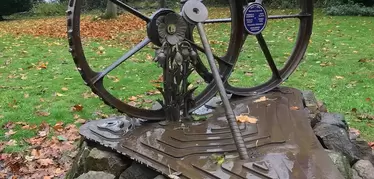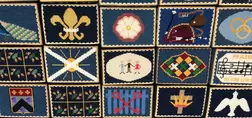St. Andrew's, Bolam.
World War Two Bombing Miracle.
Unspolit Romanesque church with Anglo-Saxon tower, medieval grave slabs and amazing views. Spirituality and a sense of peace seep from its ancient stones. Survived a German bomb being dropped which fortunately did not explode! Unique quatrefoil piers with broad moulded capitals.
Our church is currently open 10am to 4pm every day.
NE61 3UA.
World War Two Bombing Miracle.
Unspolit Romanesque church with Anglo-Saxon tower, medieval grave slabs and amazing views. Spirituality and a sense of peace seep from its ancient stones. Survived a German bomb being dropped which fortunately did not explode! Unique quatrefoil piers with broad moulded capitals.
Our church is currently open 10am to 4pm every day.
NE61 3UA.
A small, rural parish in the heart of Northumberland. Here is an old sketch map of the parish area, showing the church near the northern boundary.
Christians believe that it is possible to have a relationship with God through his son Jesus Christ: the New Covenant. Because Christianity is about relationship and community, the best way is to meet Christians as well. Come and join us.
There are many ways to contribute to the life of the church. To help financially, please donate ideally with a regular Direct Debit or Standing Order. Please ask the Hon Treasurer for details. Or you can use the QR code on the Donate to Bolam Church page.
Christians believe that it is possible to have a relationship with God through his son Jesus Christ: the New Covenant. Because Christianity is about relationship and community, the best way is to meet Christians as well. Come and join us.
There are many ways to contribute to the life of the church. To help financially, please donate ideally with a regular Direct Debit or Standing Order. Please ask the Hon Treasurer for details. Or you can use the QR code on the Donate to Bolam Church page.
Baptisms
Performed at a service often called a Christening, is the beginning of the most exciting journey in faith and St Andrew's church Bolam is the perfect place to start that journey. Call the Vicar to hear all about it.
Weddings
Not many people are lucky enough to get married in Bolam church, which can seat about 150 people, but we think it is special.
Funerals
There is no place more spiritual and soothing to bid farewell or to celebrate a life than Bolam church. Anyone who lives in the parish area is entitled to be buried in the churchyard and our Priest will be pleased to help you in any way.
Music
Music is an important part of our worship and we are fortunate to have the services of Margaret Roberson and Jim Grant as organists.
Performed at a service often called a Christening, is the beginning of the most exciting journey in faith and St Andrew's church Bolam is the perfect place to start that journey. Call the Vicar to hear all about it.
Weddings
Not many people are lucky enough to get married in Bolam church, which can seat about 150 people, but we think it is special.
Funerals
There is no place more spiritual and soothing to bid farewell or to celebrate a life than Bolam church. Anyone who lives in the parish area is entitled to be buried in the churchyard and our Priest will be pleased to help you in any way.
Music
Music is an important part of our worship and we are fortunate to have the services of Margaret Roberson and Jim Grant as organists.
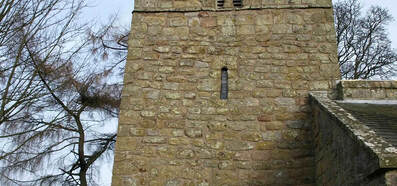
The church tower was built just over a thousand years ago by the Saxons. It appears to have four levels, but the top two windows open into the belfry.
The main belfry window opening has a classic Saxon rounded shaft in the middle, said to be made by applying wood turning techniques.
The solitary bell is dated 1732, with a diameter of 17 inches and weighs about 140lbs. It is thought to have been cast at the Phoenix foundry in Byker, one of only nine made there (opposite what is now the City Farm). It was bought by the PCC on 11th December 1732 for £11.10s.3d.
The stonework varies as you go up the tower, but it is thought not to mean that it was built in stages, except the parapet at the very top which is a later renewal.
The main belfry window opening has a classic Saxon rounded shaft in the middle, said to be made by applying wood turning techniques.
The solitary bell is dated 1732, with a diameter of 17 inches and weighs about 140lbs. It is thought to have been cast at the Phoenix foundry in Byker, one of only nine made there (opposite what is now the City Farm). It was bought by the PCC on 11th December 1732 for £11.10s.3d.
The stonework varies as you go up the tower, but it is thought not to mean that it was built in stages, except the parapet at the very top which is a later renewal.
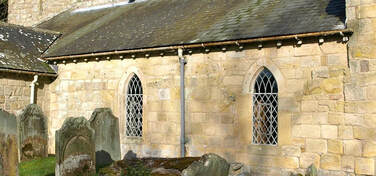
The door to the church opens into the south aisle, which was added as a sort of lean to arrangement in the twelfth century, with the arcades and piers created in the nave wall to join the two spaces together.
Around the door is a pattern called dogtooth carved into the stone. The alignment of the pattern on the stones is not very tidy and this is a clue to the fact that the south aisle was widened, probably when the Shortflatt chapel was added in the 14th century.
Around the door is a pattern called dogtooth carved into the stone. The alignment of the pattern on the stones is not very tidy and this is a clue to the fact that the south aisle was widened, probably when the Shortflatt chapel was added in the 14th century.
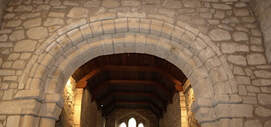
The arch from the nave into the chancel appears to have been rebuilt when the nave was enlarged, but not symmetrically.
You can see in the picture how the shield shaped carvings are not evenly spaced. These used to feature grotesque faces, but they were hacked off by an irate Reverend Meggison around 1818 after the Sunday School children persisted in pulling faces to match. But there are two faces remaining, one is just visible in the picture above, at the top of the inner, left hand pillar of the arch.
This one is just a face with a solemn expression, whereas the other carving, which looks into the chancel, has arms and legs, sports a mischievous grin and is clearly up to no good: our sole reminder of persisting Anglo-Saxon pagan belief.
You can see in the picture how the shield shaped carvings are not evenly spaced. These used to feature grotesque faces, but they were hacked off by an irate Reverend Meggison around 1818 after the Sunday School children persisted in pulling faces to match. But there are two faces remaining, one is just visible in the picture above, at the top of the inner, left hand pillar of the arch.
This one is just a face with a solemn expression, whereas the other carving, which looks into the chancel, has arms and legs, sports a mischievous grin and is clearly up to no good: our sole reminder of persisting Anglo-Saxon pagan belief.
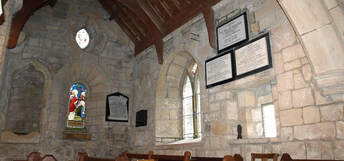
The chapel, currently referred to as the Shortflatt Chapel or sometimes Dent chapel, is now so named because it was built by Robert de Reymes, who had inherited half the barony of Bolam. He was a knight and lived at Shortflatt, as did his descendants for the following three hundred years. Shortflatt eventually passed to the Dent and now the Hedley-Dent family.
Robert acquired Shortflatt in 1296, the same year that war broke out with Scotland. He rebuilt Shortflatt Tower in stone with a licence to crenellate in 1305, after it had been burnt down. The town of Bolam was granted a market and a fair the same year, but Bolam castle was described as dilapidated. He died in 1324 and there is an effigy of him (without legs) in the chapel. It is thought the effigy was shortened to fit in the niche, which originally almost certainly would have contained a statue of Our Lady.
The chapel was clearly a chantry, owing to the recess still visible in the north wall that would have been used as an aumbry. Our Lady was held in a central position in medieval worship. She was the primary intercessor and hence integral to liturgy. For example, the wording of the Gloria, which we still use today, was different then. For example:
...thou that takest away the sins of the world, receive our prayer, to the glory of Mary.
Thou that sittest at the right hand of the Father, have mercy upon us.
For thou only art holy, sanctifying Mary;...
Further evidence that it was a Lady Chapel can be found in the will, dated 20th May 1544, of Thomas Middleton of Belsay, who 'desire to be buried in the south side of Our Lady porch in Bollom Church as near to my father's grave as conveniently may be'. The existing porch wasn't built then, so he meant the chapel.
It is also no surprise that there is a medieval vault in the chapel, since these were always dedicated to Our Lady. It contains, amongst others much older perhaps, several members of the Dent / Hedley Dent family.
Robert acquired Shortflatt in 1296, the same year that war broke out with Scotland. He rebuilt Shortflatt Tower in stone with a licence to crenellate in 1305, after it had been burnt down. The town of Bolam was granted a market and a fair the same year, but Bolam castle was described as dilapidated. He died in 1324 and there is an effigy of him (without legs) in the chapel. It is thought the effigy was shortened to fit in the niche, which originally almost certainly would have contained a statue of Our Lady.
The chapel was clearly a chantry, owing to the recess still visible in the north wall that would have been used as an aumbry. Our Lady was held in a central position in medieval worship. She was the primary intercessor and hence integral to liturgy. For example, the wording of the Gloria, which we still use today, was different then. For example:
...thou that takest away the sins of the world, receive our prayer, to the glory of Mary.
Thou that sittest at the right hand of the Father, have mercy upon us.
For thou only art holy, sanctifying Mary;...
Further evidence that it was a Lady Chapel can be found in the will, dated 20th May 1544, of Thomas Middleton of Belsay, who 'desire to be buried in the south side of Our Lady porch in Bollom Church as near to my father's grave as conveniently may be'. The existing porch wasn't built then, so he meant the chapel.
It is also no surprise that there is a medieval vault in the chapel, since these were always dedicated to Our Lady. It contains, amongst others much older perhaps, several members of the Dent / Hedley Dent family.
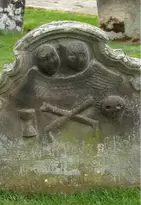
The Churchyard
The churchyard is open for burials. You don't have to be a churchgoer to have a church funeral.
The wall around the churchyard was built in 1754. Believe it or not, there are sixteen listed monuments in the churchyard, including the gate! The oldest legible inscription on a headstone is dated 1697 and reads:
Hic jacet corpus Marci Ansley de Gallow-hill. Obiit II de Aprilis anno etatis......: salutis humanae 1697.
In the north west corner behind the church there is a War Grave:
Hugh Jeffrey Middleton Lt. R.N. 1879 - 1914.
Having been in the RNVR he was assigned to HMS Columbine (previously named HMS Wild Swan), which was a depot ship in Rosyth.
Two further casualties of World War I are also commemorated on headstones:
John Henry Surtees killed in action in France October 13th 1914
Rifleman John William Ellison killed in action Sept 15th 1916.
The churchyard is open for burials. You don't have to be a churchgoer to have a church funeral.
The wall around the churchyard was built in 1754. Believe it or not, there are sixteen listed monuments in the churchyard, including the gate! The oldest legible inscription on a headstone is dated 1697 and reads:
Hic jacet corpus Marci Ansley de Gallow-hill. Obiit II de Aprilis anno etatis......: salutis humanae 1697.
In the north west corner behind the church there is a War Grave:
Hugh Jeffrey Middleton Lt. R.N. 1879 - 1914.
Having been in the RNVR he was assigned to HMS Columbine (previously named HMS Wild Swan), which was a depot ship in Rosyth.
Two further casualties of World War I are also commemorated on headstones:
John Henry Surtees killed in action in France October 13th 1914
Rifleman John William Ellison killed in action Sept 15th 1916.
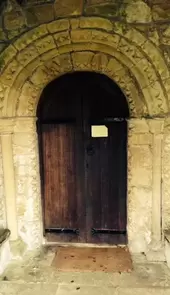
The Porch
The porch of medieval churches was a busy place, because several important community activities would have taken place here including baptisms, weddings, perhaps Sunday School and some business deals. Apart from by the occasional hiker or biker the seats are hardly used these days, but they would have been essential then. The round arched doorway has 13th century dogtooth carving around it and reaching all the way down to the ground, a feature it shares with Hartburn church. The pattern at its best is usually shaped like four flower petals. The outermost nutmeg carving is more a 12th century style. Above it in the church wall is a reused gravestone.
To the right of the door is evidence of a mass dial.
The porch of medieval churches was a busy place, because several important community activities would have taken place here including baptisms, weddings, perhaps Sunday School and some business deals. Apart from by the occasional hiker or biker the seats are hardly used these days, but they would have been essential then. The round arched doorway has 13th century dogtooth carving around it and reaching all the way down to the ground, a feature it shares with Hartburn church. The pattern at its best is usually shaped like four flower petals. The outermost nutmeg carving is more a 12th century style. Above it in the church wall is a reused gravestone.
To the right of the door is evidence of a mass dial.

Our stained glass windows are all in the chapel. On the south wall there is an angel holding a banner, which is the work of William Wailes of Gateshead, about 1892.
